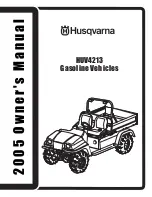
1
SECTION 1
GENERAL INFORMATION
1.1 AMPHIBIOUS OPERATION
All models of the ARGO are amphibious and capable of tra-
versing calm water. Special operating procedures and safety
precautions must be observed before entering the water and
during amphibious operation. Do not drive your vehicle into
water until you have read Section 5.6 Amphibious Opera-
tion.
1.2 MAINTENANCE PROCEDURES
Maintenance procedures described in this manual can be car-
ried out by the operator. These procedures include:
1. checking fluid levels
2. changing the engine and transmission oil
3. cleaning and replacing filters
4. preventative maintenance
5. inspections, adjustments, repairs and trouble-shooting
If you perform your own maintenance, carefully follow the
lubrication and preventative maintenance schedule (Section
7.5). By following this schedule, you will receive trouble
free, long term service from your vehicle. The following
comprehensive ARGO service information is available:
•
673-00 1977-1986 ARGO Service Manual
•
673-01 1987 ARGO Service Manual
•
673-02 1988 Supplement
•
673-10 Service Manual (673-01 & 02)
•
673-25 Argo Service Video
Your Argo dealer will perform regular maintenance and lu-
brication for a reasonable service charge.
The trouble-shooting chart (Section 8) contains information
for locating and correcting mechanical problems. In many
cases, potential problems can be identified by unusual noises,
sluggishness or vibration, before they result in a breakdown.
Refer to the chart to identify these symptoms. Take immedi-
ate corrective action or take the vehicle to an Argo dealer for
service.
This manual does not provide detailed maintenance or serv-
icing information for the engine. Refer to the engine manu-
facturer’s manual (supplied with each Argo) for important
warranty, service and operating information.
If the engine requires servicing, take the vehicle to an au-
thorized engine service outlet.
1.3 WIND CHILL FACTOR
Why does it feel much colder outdoors on a windy day than
when there’s no wind, especially in winter?
The cooling effect of the wind makes it feel that it’s colder
than it really is. This combined effect of wind and low tem-
perature is known as the “wind chill factor”.
Argo operators should be aware of the wind chill factor. Dress
warmly and make sure exposed skin is protected. Pay par-
ticular attention that young passengers are properly “bun-
dled up” with their hands and faces well protected.
1.4 MODEL IDENTIFICATION
The vehicle identification plate is fastened to the dash. Ref-
erence Section 1.6 for the exact location. The model and
serial numbers are stamped into it. Model identification starts
with “V”, followed by five numbers. The four or five digit
serial number begins with one of the following prefixes:
S - 6x6 Vanguard (Mechanical Brakes)
SN - 6x6 Vanguard2 (Hydraulic Brakes)
BF - Bigfoot
RB - 8x8 Response
CB - Conquest
Carefully observe the maximum load capacity for your vehi-
cle on land and in water as listed in the following:
WIND CHILL
Wind Speed
km/h 8 16 24 32 40 48 56 64
Actual Temp.(C)
0
-5
-10
-15
-20
-25
-30
-35
-40
-45
-50
-2
-7
-12
-18
-23
-28
-33
-39
-44
-49
-54
-8
-14
-20
-26
-32
-38
-45
-51
-57
-63
-69
-11
-18
-25
-32
-38
-45
-52
-59
-65
-72
-79
-14
-21
-28
-35
-43
-50
-57
-64
-71
-78
-85
-16
-23
-31
-38
-46
-53
-61
-68
-75
-83
-90
-17
-25
-33
-40
-48
-56
-63
-71
-79
-86
-94
-19
-26
-34
-42
-50
-57
-65
-73
-81
-89
-96
-19
-27
-35
-43
-51
-59
-67
-75
-83
-90
-98
Gradually
Increasing
Danger
Dangerous
Extremely
Dangerous
Содержание 6x6 Bigfoot
Страница 5: ...NOTES III...
Страница 6: ...NOTES IV...
Страница 13: ...3 SECTION 1 GENERAL INFORMATION 1 6 IDENTIFICATION AND LOCATION OF CONTROLS...












































